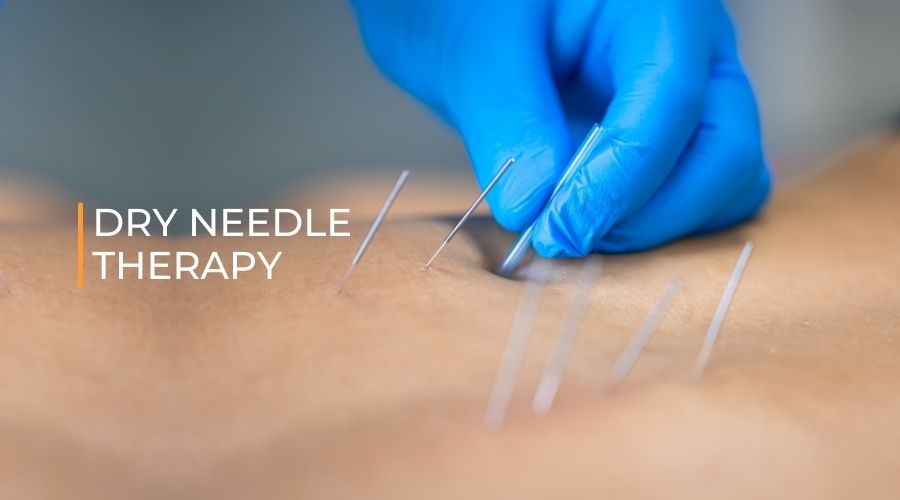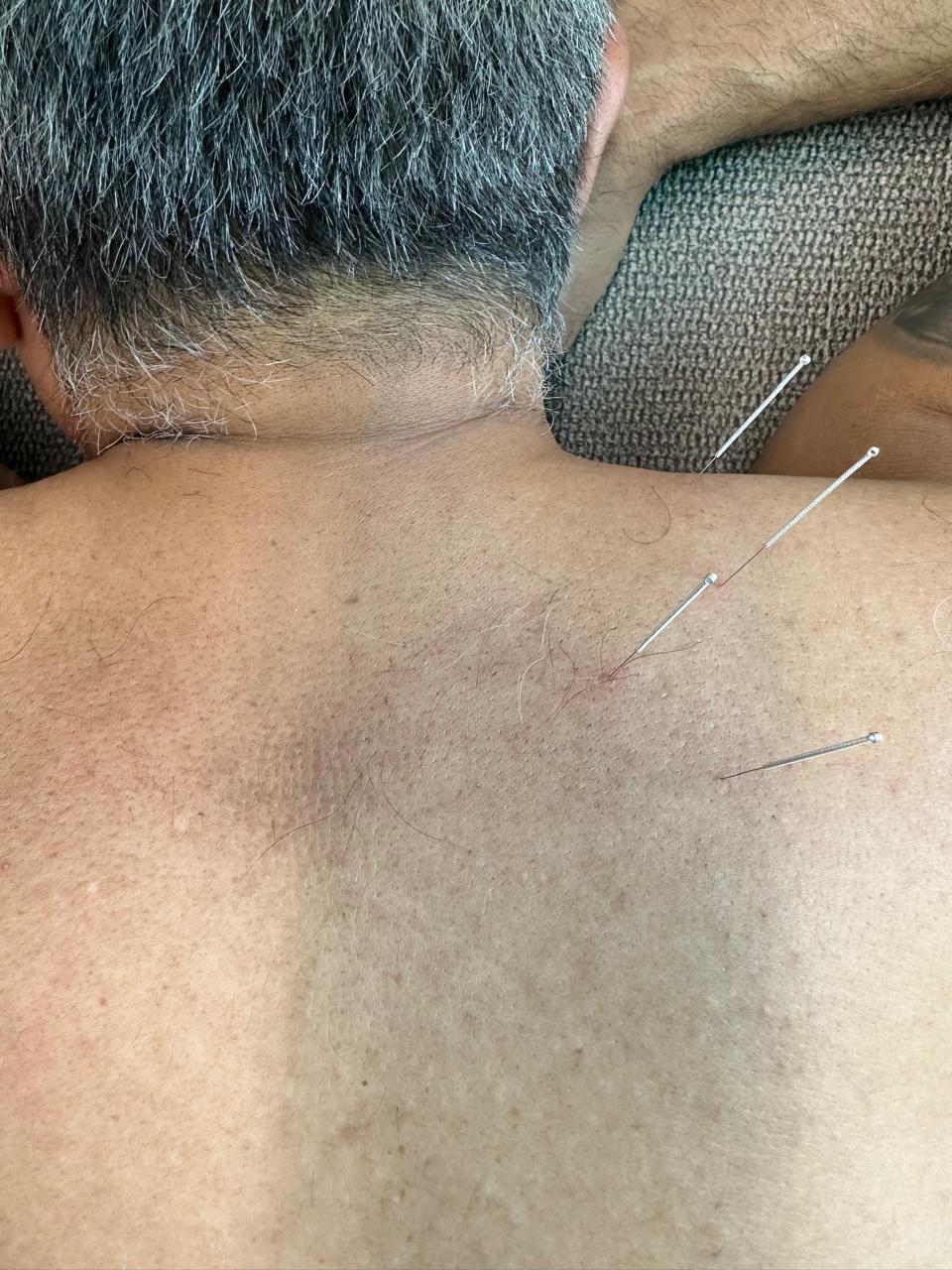Dry Needle Therapy
Home / Dry Needle TherapyDry Needle Therapy in Delhi

Muscle pain can be a constant companion, hindering our daily activities and overall well-being. Dry needling therapy emerges as a powerful tool in a physiotherapist’s arsenal to combat this very issue. But how exactly does it work?
Let’s delve into the science behind dry needling and explore its application for upper trapezius pain and tennis elbow.
How Does Dry Needling Work?
Dry needling utilizes thin, solid filiform needles inserted into specific points in your muscle tissue. Unlike acupuncture, it doesn’t involve injecting any substances.
The target areas are known as myofascial trigger points, often felt as taut bands or nodules within the muscle. These trigger points are believed to contribute to pain, tightness, and restricted movement.
The exact mechanism of dry needling’s pain-relieving effects is still under investigation, but several theories prevail:
- Local Twitch Response: Inserting the needle into a trigger point can sometimes elicit a brief involuntary muscle contraction, known as a local twitch response. This twitch is thought to help break down adhesions and normalize muscle function.
- Improved Blood Flow: Chronic tightness in trigger points can restrict blood flow to the area. Dry needling is believed to improve circulation, bringing fresh oxygen and nutrients to promote healing and reduce pain.
- Pain Modulation: The needles might stimulate the nervous system, triggering the release of endorphins, the body’s natural pain relievers. This can lead to a reduction in pain perception.
- Neuromodulation: Dry needling may influence the way nerves transmit pain signals to the brain, further contributing to pain relief.
Dry Needling is indicated in various conditions like:
- Acute myofascial pain with the presence of trigger points.
- Whiplash injuries
- Neck pain
- Low back pain
- Osteoarthritis of Knees
- Fibromyalgia
- Tendinopathies like tennis elbow, achilles tendinitis, biceps tendinitis
- Rotator Cuff Injuries | Frozen Shoulder
- Strains like tempero-mandibular joint strain.
Dry Needling for Upper Trapezius Pain
 The upper trapezius muscle sits on the upper back, connecting the neck to the shoulder blade. It’s a prime culprit for pain and tension, often caused by poor posture, prolonged computer use, or carrying heavy bags. Here’s how dry needling can help:
The upper trapezius muscle sits on the upper back, connecting the neck to the shoulder blade. It’s a prime culprit for pain and tension, often caused by poor posture, prolonged computer use, or carrying heavy bags. Here’s how dry needling can help:
- Identifying Trigger Points: A physiotherapist will assess your posture, range of motion, and palpate the upper trapezius to locate trigger points.
- Targeting the Tightness: The needles are inserted precisely into these trigger points, aiming to release the tension and alleviate pain.
- Improved Range of Motion: By addressing the tightness, dry needling can improve neck and shoulder movement, allowing for better posture and reduced risk of future pain.
Dry Needling for Tennis Elbow
 Tennis elbow, medically termed lateral epicondylitis, is a common condition causing pain on the outer elbow. It’s often linked to repetitive motions, such as using a computer mouse or playing racquet sports. Here’s how dry needling can provide relief:
Tennis elbow, medically termed lateral epicondylitis, is a common condition causing pain on the outer elbow. It’s often linked to repetitive motions, such as using a computer mouse or playing racquet sports. Here’s how dry needling can provide relief:
- Deactivating Trigger Points: Trigger points in the forearm muscles can contribute to tennis elbow pain. Dry needling deactivates these trigger points, reducing pain and inflammation.
- Enhanced Blood Flow: Improved blood circulation to the affected area promotes healing and reduces pain sensitivity.
- Faster Recovery: Dry needling can accelerate the recovery process, allowing you to return to your activities sooner.
Important Considerations Before Dry Needling
While generally safe, dry needling is not suitable for everyone. It’s crucial to consult a qualified physiotherapist experienced in dry needling to determine if it’s the right approach for you. Here are some factors to consider:
- Pre-existing medical conditions: Certain medical conditions like bleeding disorders or uncontrolled infections might make dry needling unsuitable.
- Pregnancy: Dry needling is generally not recommended during pregnancy.
- Medication use: Some medications can increase the risk of bleeding during dry needling.
Unlocking Pain Relief with DelhiPhysioCare
At DelhiPhysioCare, our team of experienced physiotherapists utilizes dry needling as part of a comprehensive treatment plan for various musculoskeletal conditions.
We combine dry needling with manual therapy exercises, and stretching techniques to achieve optimal results.
Are you struggling with acute or chronic pains?
Don’t let pain limit your life.
Contact DelhiPhysioCare today to schedule a consultation and explore if dry needling therapy can help you get back to pain-free movement. Book a consultation with us today to get rid of your pain.
QUICK ENQUIRY
Send us a message with your contact details and one of our staff will contact you right away.
TREATMENTS
BOOK AN APPOINTMENT
GENERAL ENQUIRIES
235, Avtar Enclave,Paschim Vihar,Delhi – 110063
Carpal Tunnel Syndrome FAQ’s
Physiotherapy is essential to manage carpal tunnel syndrome, build muscle and improve function, but therapy alone is not always enough to solve the problem.
The therapy patients receive weekly half-hour manual therapy sessions during which only their hands were used, with our physical therapists focusing on the neck and the median nerve.
Carpal tunnel syndrome (CTS) is a common cause of hand pain and numbness, and it is often caused by overuse. Fortunately, if you’re suffering from this common injury, you do not have to stop exercising or attending your favorite fitness classes.
Carpal tunnel syndrome is caused by repeated fingers and wrist movements, awkward hand movements, vibrations, and mechanical strain on the palm. Most tasks involving CTS involve strong pulling, pulling, pushing, or twisting.
Most racket sports, handball, swimming, bodybuilding, rowing, golf, archery, and rock climbing have high rates of carpal tunnel syndrome, although any sport that requires the wrist and hand to be used for extended periods can be affected.
Numbness and tingling in the fingers can occur in as little as 60 seconds for those with carpal tunnel syndrome, and the sooner symptoms are felt, the worse the carpal tunnel syndrome. If there is limited wrist motion, arthritis, or a history of trauma, X-rays of the wrist may be required.
You may first experience periodic tingling or numbness in your fingers. The sensations may get worse over time, lingering longer or even waking you up at night. If you continue to ignore carpal tunnel, it may lead to permanent nerve damage.
